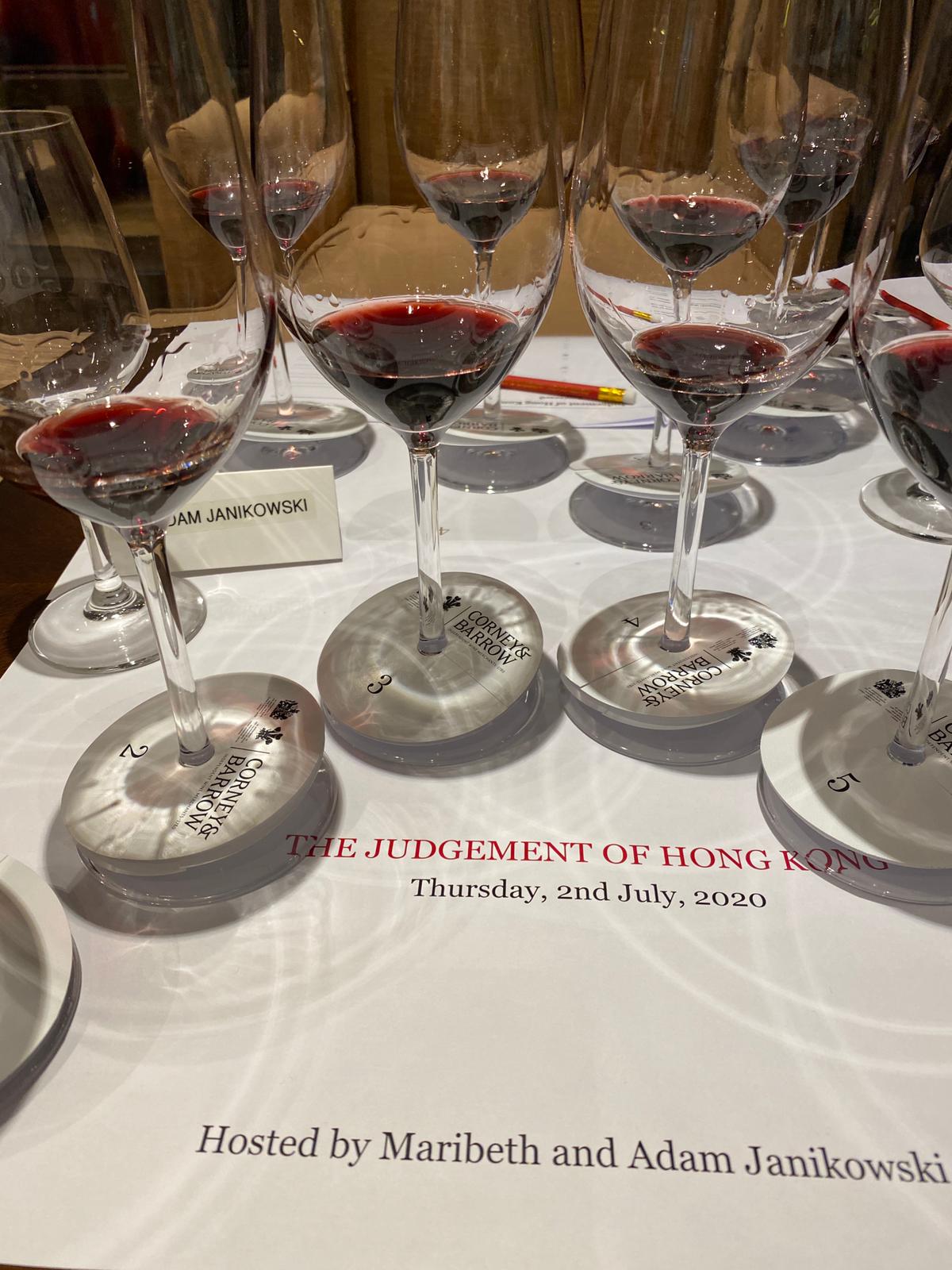Another Great Showing for the Best Chinese Wines

Maribeth and Adam Janikowski stand next to the score chart after the Bordeaux-versus-China blind tasting.
A blind tasting in Hong Kong last week (July 2) with a small group of luminaries, from the head of a major property company to an Oscar-winning movie director, provided greater evidence that China is producing world-class wines.
The tasting pitted six top Chinese wines against six famous Bordeaux, including great names such as Chateau Lafite Rothschild, Château Pichon Longueville Lalande and Château Pichon-Longueville Baron. The wines were served in six pairs with a French and a Chinese red. The 16 tasters voted for their favorite wine in each pair, and China won four out of the 12 pairs and tied the other two. Bordeaux failed to win a single pairing.
The overall winner was LVMH’s 2015 Ao Yun Shangri-la, the cabernet sauvignon blend from northern Yunnan Province in southwestern China. The red was open, complex and loaded with currant, sweet berry, tobacco and hints of cedar in the nose and on the palate. By comparison, the Lafite, which was Ao Yun’s companion bottle in the pairing, was tight yet incredibly long and powerful at the finish. I was one of the few who preferred the first growth because it showed such incredible power and length and potential for aging.
In fact, all the Bordeaux, except for the Lafon-Rochet, which seemed to be a slightly bad bottle, were much tighter, more polished and tannic than the Chinese reds, which showed more ripeness and even a slightly stewed character to them. The latter were much more attractive to taste and drink now.
I believe most of the people in the tasting were rating the wines for their current drinking pleasure and not for the future or on a professional level. But it doesn’t matter. The fact is that in almost every pair of reds the Chinese wines were preferred for their quality by a consensus, proof, if you needed it, that the best Chinese wines of today can easily be placed on the table next to France’s best bottles of comparable wines.
“I had no idea that China made such outstanding wines,” said a Chinese-Canadian woman, who admitted that she preferred the Chinese red in every flight.
- The tasting pitted the best of China against the best of Bordeaux.
- Attendees included the head of a property company and an Oscar-winning director.
- China producer Ao Yun, owned by LVMH, produced one of the highest-scoring wines.
Canadian businessman Adam Janikowski organized the tasting, which he aptly named the Judgement of Hong Kong. It was a nod to the famous Paris tasting in the mid-1970s when Napa Valley wines beat the best of France but, of course, his wine event was more for amusement than the grandeur of the Paris event decades ago.
“I have been working on this since 2013,” Janikowski told the group. He started tasting and drinking top Chinese wines around the same time and continued to taste and meet winemakers to find out more about the wines. “I wanted to find out more about Chinese wines and I contacted all the winemakers through WeChat (the Chinese social media channel.)”
JamesSuckling.com has been following the development of super premium Chinese wines for some time now. Late last year our Beijing-based Associate Editor Zekun Shuai and I reviewed about 150 wines. A number of other top reds are being produced in the vast country and they are not simply emulating Bordeaux. Marselan and syrah are two grape types to watch for the future as are some small hands-on winemakers.
I organized a tasting in Beijing in November that was similar to the Janikowski event for a handful of Chinese winemakers as well as the owners of icon Chilean wines such as Sena, Clos Apalta and Almaviva. The results were similar in many ways. We did not vote for the best wines at the event but all of the Chinese wines compared well to the Chilean reds, and many of the same wineries were in my tasting as well as Janikowski’s last week.
I still remember how surprised a journalist from Beijing’s China Daily newspaper was at the tasting. He said, “I now understand that our best wines can compare to the best wines of the West.”
Most of the people I spoke to at the tasting last week said more or less the same thing: they now understand that China can make world-class wines. The participants’ biggest problem now is to find the bottles they liked, because most are hard to buy at retail in just about any place outside of the People’s Republic of China. Plus, they tend to cost upwards of US$100 a bottle. Maybe that will change soon with the continued improvement in quality and the growing buzz in the global market about the great wines of China.
See my notes and scores for the full set of 12 wines below. These do not include ratings or opinions from other tasters at the event.


